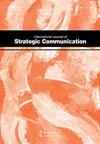Fake-News Network Model: A Conceptual Framework for Strategic Communication to Deal with Fake News
IF 1.9
Q1 COMMUNICATION
International Journal of Strategic Communication
Pub Date : 2022-01-01
DOI:10.1080/1553118X.2021.1988616
引用次数: 1
Abstract
ABSTRACT This article analyzes the entire life span of a corporate fake-news report as a case study, proposing a conceptual framework for strategic fake-news communication. Using the confirmation-bias theoretical model, this qualitative textual analysis examines the most widely circulated tweets of a fake-news item about Nike, 603 replies to the tweets, users’ biographical profiles (e.g., political affiliations), the role of opinion leader(s), and relevant prior contexts. The findings provide in-depth insight into how people believe fake news and how their conversations about fake news (re)shape the victim brand’s social realities. Overall, the findings of this study illustrate a “Fake-News Network Model” that explains the underlying mechanisms of how a fake-news item functions together with other aspects (e.g., context, perception, opinion leaders, and cognitive processes), prompting certain people to believe particular fake-news reports and, discuss the victim brand (e.g., Nike) based on that perceived truth. The article discusses the implications of this network model for both fake-news researchers and strategic communication professionals.假新闻网络模型:应对假新闻战略传播的概念框架
摘要本文以企业假新闻报道的整个生命周期为例进行分析,提出了战略性假新闻传播的概念框架。使用确认偏差理论模型,该定性文本分析检查了关于耐克的假新闻最广泛传播的推文、603条推文回复、用户的个人简历(例如,政治派别)、意见领袖的角色以及相关的先前背景。这些发现深入了解了人们是如何相信假新闻的,以及他们关于假新闻的对话是如何(重新)塑造受害者品牌的社会现实的。总的来说,这项研究的结果说明了一个“假新闻网络模型”,该模型解释了假新闻如何与其他方面(如背景、感知、意见领袖和认知过程)一起发挥作用的潜在机制,促使某些人相信特定的假新闻报道,并根据感知到的真相讨论受害者品牌(如耐克)。本文讨论了这种网络模式对假新闻研究人员和战略传播专业人士的影响。
本文章由计算机程序翻译,如有差异,请以英文原文为准。
求助全文
约1分钟内获得全文
求助全文
来源期刊

International Journal of Strategic Communication
Social Sciences-Sociology and Political Science
CiteScore
3.40
自引率
0.00%
发文量
39
期刊介绍:
The International Journal of Strategic Communication examines the philosophical, theoretical, and applied nature of strategic communication, which is “the purposeful use of communication by an organization to fulfill its mission.” IJSC provides a foundation for the study of strategic communication from diverse disciplines, including corporate and managerial communication, organizational communication, public relations, marketing communication, advertising, political and health communication, social marketing, international relations, public diplomacy, and other specialized communication areas. The IJSC is the singular forum for multidisciplinary inquiry of this nature.
 求助内容:
求助内容: 应助结果提醒方式:
应助结果提醒方式:


